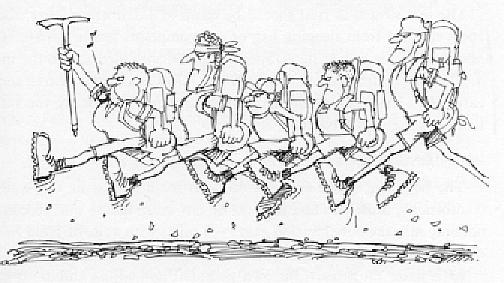 ™
™TRADITIONAL MOUNTAINEERING
™
www.TraditionalMountaineering.org
™ and also
www.AlpineMountaineering.org
™
 ™
™
FREE BASIC TO ADVANCED
ALPINE MOUNTAIN CLIMBING INSTRUCTION™
Home
| Information
| Photos
| Calendar
| News
| Seminars
| Experiences
| Questions
| Updates
| Books
| Conditions
| Links
| Search
![]()
Interested friends have been talking about the volunteer leader’s responsibilities and how the
one can promote safe climbing by informing followers of what to expect on each outing.
A very experienced climber asked me to write about being a good follower.
A good follower will have done the best possible job in learning about the leader and assistants, the mountain, the route, the equipment and skills needed, the elevation gain and proposed rate of climb, and the goals and way the climb will be conducted. The good team member will have checked the weather and the avalanche
risk reports too, if appropriate.
The good follower will judge for himself if he can be a safe member of the climbing party.
Nothing is more difficult than having a member of the climbing party who has not done any preparation and is clearly not able to keep pace with the group based on aerobic capacity, technical skill and experience. Sometimes climbs fail their goals because one person did not fit the profile of the rest of the participants.
The leader and the follower share responsibility for a misfit.
That being said, all followers share responsibility for keeping the party together. Each member is responsible for the person behind and must slow up or stop to allow people to catch up. An
individual's pack-off stop to take off a jacket requires the group to slow or
perhaps stop together.
The leader may be ahead - the followers must make him aware of the need to stop.
No amount of pressure can make a participant work beyond his or her aerobic capacity for more than a few minutes. The group is limited to the pace of the slowest person and faster folks should enjoy the chance to relax.
Mountaineering is not about a personal contest with others.
If the leader is making a dangerous decision, it is the responsibility of the followers to question and express their concern
to the leader. In connection with a 1998 climb of Mt. Hood when a
person died, the followers were faulted for not speaking up about the posted avalanche
conditions. Obviously, if the leader misses a trail junction, the followers must bring it to his attention, not just blindly follow.
There are three other traditional group climb imperatives: the participants must agree to cooperate with the leaders and recognize their authority to conduct the outing. They must also agree to keep the group together and remain with the group and help the group in case of an accident or emergency.
They must agree to remain at the road head after the outing until everyone is accounted for and all vehicles are started.
Mountaineering is about shared companionship and the mitigation of great risk by a climbing group effort. Read the section “Everyone a Leader” on page
470 of Mountaineering, The Freedom of the Hills, 8th Edition and Chapter 10, “Style and Ethics” in NOLS Wilderness Mountaineering, 1993.
--On Belay! Bob Speik
Copyright© 1995-2015 by Robert Speik. All Rights
Reserved.
![]()
![]()
![]() WARNING - *DISCLAIMER!*
WARNING - *DISCLAIMER!*
Mountain climbing has inherent dangers that can in part, be mitigated
Read more . . .
About Alpine Mountaineering:
The Sport of Alpine Mountaineering
Climbing Together
Following the Leader
The Mountaineers' Rope
Basic Responsibilities
![]() Cuatro Responsabiliades Basicas de Quienes Salen al Campo
Cuatro Responsabiliades Basicas de Quienes Salen al Campo
The Ten Essential Systems
![]() Los Diez Sistemas Esenciales
Los Diez Sistemas Esenciales
Our Leader's Guidelines:
Our Volunteer Leader Guidelines
Sign-in Agreements, Waivers and Prospectus
This pdf form will need to be signed by you at the trail head
Sample Prospectus
Make sure every leader tells you what the group is going to do; print a copy for your "responsible person"
Participant Information Form
This pdf form can be printed and mailed or handed to the Leader if requested or required
Emergency and Incident Report Form
Copy and print this form. Carry two copies with your Essentials
![]()
Participant and Group First Aid Kit
Print this form. Make up your own first aid essentials (kits)
![]()

No, this is not what we mean!